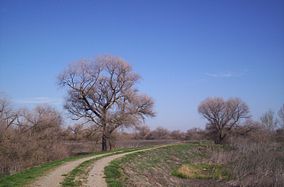San Luis National Wildlife Refuge
| San Luis National Wildlife Refuge | |
|---|---|
IUCN category IV (habitat/species management area) | |
 North levee, San Luis Refuge - March, 2007 | |
 Map of the United States | |
| Location | Merced County, California, United States |
| Nearest city | Los Banos, California |
| Coordinates | 37°12′00″N 120°48′04″W / 37.19994°N 120.80103°WCoordinates: 37°12′00″N 120°48′04″W / 37.19994°N 120.80103°W[1] |
| Area | 26,600 acres (108 km2) |
| Established | 1966 |
| Governing body | U.S. Fish and Wildlife Service |
| Website | San Luis National Wildlife Refuge |
The San Luis National Wildlife Refuge in the San Joaquin Valley of central California is one of the great remnants of a historically bountiful wintering grounds for migratory waterfowl on the Pacific Flyway. Located in the Bear Creek, Salt Slough, and San Joaquin River floodplain, it hosts a myriad of tree-lined channels and oxbows, wetlands and native grasslands.
Thousands of acres of wetlands, fed by an intricate set of canals, are managed to produce natural food supplies for migratory waterfowl. San Luis also contains the most extensive network of pristine native grasslands, shrubs, and vernal pools that still remain within the Central Valley.
Thousands upon thousands of mallard, pintail, green-winged teal, and ring-necked ducks flock into the managed wetlands; while the wood duck lives throughout the tree-lined slough channels.
Herons and egrets nest in mature oaks and willows and feed on the refuge's abundant frog and crayfish populations. A wide diversity of songbirds, hawks, and owls also use refuge habitat.
Hunting is allowed in the winter season on a portion of the refuge, which also holds a herd of reintroduced endangered tule elk, the smallest subspecies of all American elks.
See also[]
- Kesterson National Wildlife Refuge, a former refuge now closed due to pollution
- Kesterson Reservoir, now located within San Luis National Wildlife Refuge
References[]
- ^ "San Luis National Wildlife Refuge". Geographic Names Information System. United States Geological Survey.
![]() This article incorporates public domain material from websites or documents of the United States Fish and Wildlife Service.
This article incorporates public domain material from websites or documents of the United States Fish and Wildlife Service.
External links[]
 Media related to San Luis National Wildlife Refuge at Wikimedia Commons
Media related to San Luis National Wildlife Refuge at Wikimedia Commons- Official San Luis National Wildlife Refuge website
- IUCN Category IV
- National Wildlife Refuges in California
- Parks in the San Joaquin Valley
- San Joaquin River
- Wetlands of California
- Protected areas of Merced County, California
- Natural history of the Central Valley (California)
- Geography of Merced County, California
- Protected areas established in 1966
- 1966 establishments in California
